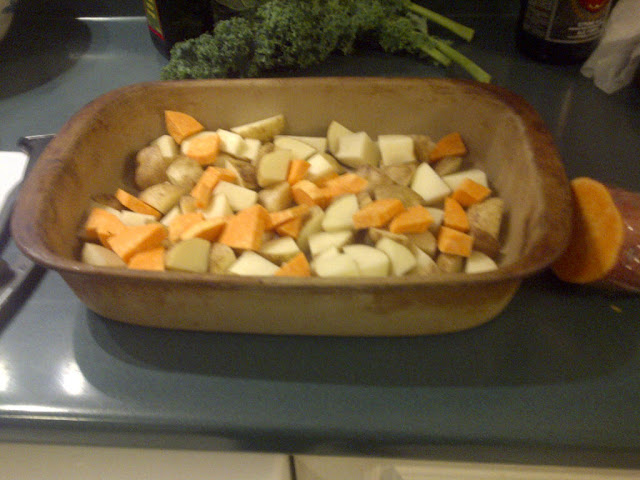A whole food, plant based diet will promote optimal health. The thing is, most people who follow a whole food, plant based diet are Vegetarian, or Vegan. I don't think I can do that, and I guarantee my family won't. There are a few reasons that at this time we won't decide to go completely Vegetarian or Vegan, but I will save that for another entry.
If we were all to prepare meals with the focus first on whole foods, vegetables, grains, fruits, and just leave the meats and cheeses to be used more like a garnish, our diets would become so much more rich in the things our bodies need so much, such as fibre, vitamins and minerals.
I plan to do some entries on how to organize your pantry and shopping towards an "almost Vegetarian" style of eating. In there we will discuss processed foods and their risks etc. For now, let's just get those veggies and whole grains and legumes, etc, out of the fridge and freezer and cupboards, and onto our plates!
Here is a Veggie Bake I made last night:
Ingredients:
8 medium sized potatoes 1/2 sweet potato
1 medium onion chopped 2 sticks celery, chopped
2 medium carrots, chopped 8 Cremini mushrooms, quartered
1 medium red pepper chopped approx 1 cup snap peas
Olive Oil Salt and pepper to taste
1/2 tsp ground cumin 1-2 tsp thyme
1-2 tsp oregano Zest of half a lemon
1 cup water 1 tsp boullion broth
Pre-heat oven to 400 degrees.
First wash and chop your potatoes and add to a baking dish
Next add the sweet potato, celery and and carrots
Take your mushrooms and chop them into quarters. I sometimes prefer this over slicing because you get to enjoy the texture of the mushroom. If you have mushroom shy family members, slice finely instead.
Add the remaining ingredients except for the red pepper and snap peas, and about 1 cup of water in the bottom of the baking dish.
This includes using a micro-plane grater to grate lemon rind, the herbs and spices, oil (for added flavor and to prevent sticking) water, boullion, etc.
Stir this thoroughly until you have the vegetables evenly coated with the spices and oil and water. The water is for the boullion to absorb into, and it also helps to "steam" the veggies as they cook.
You should have a pan that looks like this, ready to go into the oven:
Bake in a 400 degree oven for about 40 min. Stir every 10-15 minutes to ensure they cook evenly and that they don't stick. I cover my baking dish with an upside down cookie sheet to serve as a baking dish lid for the first half of the cooking. This helps to "steam" the veggies a bit.
For the second half of the cooking I uncover the dish, stir and keep baking.
In the last 8-10 minutes of baking, stir in the red pepper and snap peas. This will help them keep their bright colour and crunchy texture.
Your finished baking dish should look something like this:
Last night I served this to the family with a home made Barely Risotto.
We ate some Kale chips as an appetizer. That was dinner! Just right for the rainy Sunday night we had. Lots of nutritious comfort food.
Try adding some more vegetables to you family dinner today!
Thanks for reading,
Cassie


























